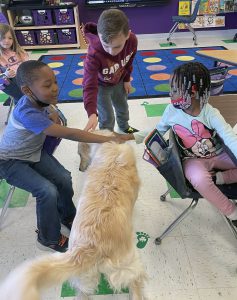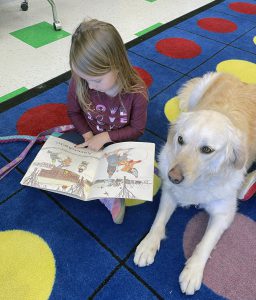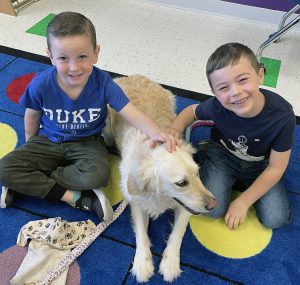
Minisink Valley Elementary School students have a new four-legged friend making visits to their classrooms and bringing smiles to their faces.
Adeline, or “Addy” as she’s known, is a 4-year-old Golden Retriever belonging to Kindergarten teacher Shawne Demberg. She’s been a member of the  Demberg family since she was eight-weeks-old and can now be considered her class’ newest “student!”
Demberg family since she was eight-weeks-old and can now be considered her class’ newest “student!”
How it began…
Addy was more than just the family’s pet. Mrs. Demberg’s son began working with her at an early age for his 4-H obedience and agility project, winning several competitions and earning a “Canine Good Citizen” title.
That success had Mrs. Demberg thinking about therapy dog training. In 2019, the duo completed their therapy dog training and testing.
“This program had us working on being less reactive to people, utilizing the wait command and teaching the dog to settle,” she said. “We were tested as a team in several locations/situations. Before the pandemic, she was coming to  school with me several days a week. Now that COVID numbers have significantly decreased, we have gotten the ok for her to return to school.”
school with me several days a week. Now that COVID numbers have significantly decreased, we have gotten the ok for her to return to school.”
There is a distinct difference between service dogs and therapy dogs. Service dogs help individuals with specific disabilities, such as visual impairment or seizure disorders. Therapy dogs provide comfort and support. They’re trained to use their social instincts and learned social skills to provide health, social-emotional and cognitive benefits.
The benefits are amazing
According to a National Institutes of Health (NIH) study, having a dog present in a classroom promotes a positive mood and provides significant anti-stress effects on the body.
 The simple act of petting a dog has the effect of lowering blood pressure and heart rate, the NIH study noted. Pet therapy also lowers stress hormones, like cortisol, and increases oxytocin. Being in contact with a therapy dog calms kids down when they’re upset and helps keep their anxiety at bay, the study said, adding that reducing feelings of anxiety and/or depression enables students to better focus on learning.
The simple act of petting a dog has the effect of lowering blood pressure and heart rate, the NIH study noted. Pet therapy also lowers stress hormones, like cortisol, and increases oxytocin. Being in contact with a therapy dog calms kids down when they’re upset and helps keep their anxiety at bay, the study said, adding that reducing feelings of anxiety and/or depression enables students to better focus on learning.
The NIH study also stressed: “The presence of a dog in an educational setting seems to support concentration, attention, motivation, and relaxation reflecting reduction of high stress levels which inhibit effective learning and performance.”
Addy has been very good at doing just that. And, the students love her.
“Studies have shown that having a dog reduces stress levels and brings a  sense of calm,” explained Mrs. Demberg. “Dogs seem to know when we are having a bad day and get closer to that person right when they need it most. Petting a dog reduces blood pressure and heart rate. The social- emotional benefits are also wonderful.”
sense of calm,” explained Mrs. Demberg. “Dogs seem to know when we are having a bad day and get closer to that person right when they need it most. Petting a dog reduces blood pressure and heart rate. The social- emotional benefits are also wonderful.”
‘Kids emulate what they see…’
When Addy is in school, she’ll be staying in Mrs. Demberg’s class for an expected two to three days a week. Similar to students interacting with their peers in other classes, Addy is also visiting classrooms in the school, so other students can experience the same social-emotional benefits….and get to spend some time with a sweet dog.
Students will have time to interact with her during free time and less structured times. In Mrs. Demberg’s classroom, students know Addy will take breaks and have time to herself in her classroom crate.
“Dogs make no judgments; they are friendly to everyone,” said Mrs. Demberg. “Kids emulate what they see; let’s not judge, let’s be friendly with everyone. Having a relationship with a pet builds trust and trustworthiness.”
